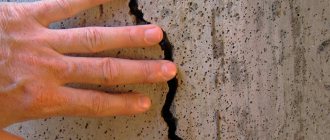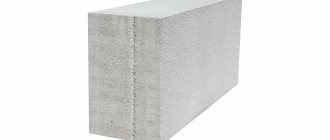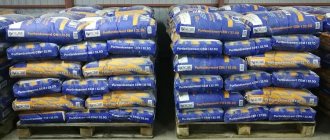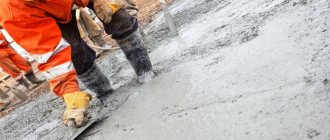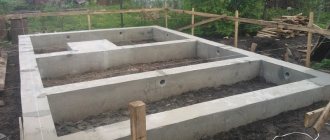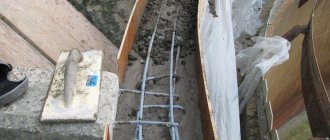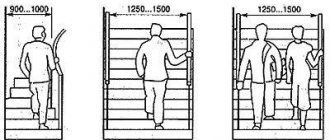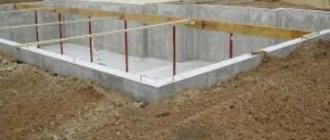Concrete is classified according to class, material strength, as well as brand and purpose, which makes it easier for buyers to choose.
Concrete mortar belongs to the category of building materials used to construct the base foundation.
It is used to construct various load-bearing structures, including foundations and interfloor ceilings.
Moreover, for each specific object, different types of concrete compositions, which include various additives, can be used.
Due to this, their classification is carried out according to strength, degree of moisture resistance and frost resistance.
According to their intended purpose, concretes are divided into:
Structural:
for concrete and reinforced concrete load-bearing structures of buildings and structures (foundation blocks, columns, beams, slabs, etc.).
Tensile concrete
: Concrete containing expansive cement or an expansive admixture that causes the concrete to expand as it hardens.
Rapid-hardening concrete
: concrete that has a rapid rate of strength development.
Highly functional concrete:
concrete that meets special functional requirements that cannot be achieved through the use of traditional components, mixing, placement, maintenance and curing methods.
Decorative concrete
: concrete obtained by processing by staining, polishing, texturing, embossing, engraving, toppings (additives) and other techniques to achieve the desired aesthetic properties.
Draining concrete
: concrete containing coarse aggregate with no or minimal content of fine aggregate, as well as an insufficient amount of cement paste to fill pores and voids.
Special:
chemically resistant, heat-resistant, decorative, especially heavy, for biological protection, concrete polymers, polymer concretes and others
The strength grade of concrete is an indicator of its compressive strength, denoted by the letter “M” and a number from 50 to 1000. The number shows the maximum permissible load that concrete of this grade can withstand (in kgf/cm2). The grade determines the standard strength of concrete (under ideal conditions).
The waterproof grade shows the ability of concrete not to allow water to pass through its pores under pressure, indicated by the letter “W” and numbers from 2 to 20. The numbers indicate the maximum water pressure that the concrete can withstand. Waterproofness is very important in the construction of swimming pools, water storage tanks, underground and underwater structures. For ordinary buildings, concrete with a waterproof grade of W2 or W4 is used.
The frost resistance grade of concrete shows how many cycles of freezing and thawing that concrete can withstand in a state of moisture saturation without significant loss of strength (permissible decrease in strength is 5%). Identified by the letter “F” and a number from 50 to 300, the number indicates the number of freezing and thawing cycles during which the strength does not decrease.
Concrete class is an indicator that takes into account the permissible error in the quality of a concrete mixture, provided that in at least 95 percent of cases its strength will correspond to the standard. That is, the class of concrete shows its actual strength.
Correspondence table for concrete grades and classes
The ratio of class and grade of concrete is given in the table:
| Concrete class | Average strength of this class (kg/cm2) | Nearest brand of concrete |
| AT 5 | 65 | M75 |
| B7.5 | 98 | M100 |
| AT 10 | 131 | M150 |
| B12.5 | 164 | M150 |
| B15 | 196 | M200 |
| IN 20 | 262 | M250 |
| B25 | 327 | M350 |
| B30 | 393 | M400 |
| B35 | 458 | M450 |
| B40 | 524 | M550 |
| B45 | 589 | M600 |
| B50 | 655 | M600 |
| B55 | 720 | M700 |
| B60 | 786 | M800 |
Classification of concrete solutions by grade
Classification of types of concrete mortars by grade is carried out in the range: from grade 50 to grade 1000.
The specified value is determined taking into account the volume of cement added to a unit of concrete mortar. The compressive strength of a concrete substance is calculated in kg per cm2.
Based on this, the name of concrete grades is indicated by the letter M, followed by numbers.
A large digital designation indicates the high strength of the solutions, which means it confirms its high quality.
Moreover, the higher the grade of concrete, the more difficult it is to work with it, since the high-density composition hardens faster.
Therefore, it is very important to choose the right concrete composition in terms of density, which would be ideal for the construction of a particular facility.
For example, when making a cushion for pouring a foundation, during road work, grade 100 or 150 concrete is used.
In the process of manufacturing blind areas, paths and screeds, the grades of concrete are increased to strength levels of 200 and 350.
At the same time, the M350 brand is considered one of the most common, since its universal properties meet all the necessary requirements for individual construction.
M350 is used in the construction of various types of foundations, in the process of erecting concrete steps and supporting elements of walls.
In addition, grade 350 has found its application in commercial construction.
With its help, foundations of a solid structure, monolithic beams and walls, as well as road surfaces are obtained, the properties of which allow them to withstand large mechanical loads.
As a result, brands such as 250 and 300 are slowly leaving the construction market.
The technical properties of grades with high digital indicators 400 and 450 make it possible to use them in the construction of hydraulic structures, with the expectation of high loads.
Higher grades of concrete - M500 and M550 - are used for the construction of structures with special technical requirements (metro, dams or dams).
Kinds:
Based on the type of binder, concrete is divided into:
- cement (prepared using clinker cements - Portland cement, Portland slag cement, Portland pozzolanic cement, etc.);
- silicate autoclave hardening (on lime-sand, lime-slag and other binders);
- limestone;
- slag;
- gypsum (on gypsum and pozzolanic binders);
- bituminous (asphalt concrete);
- synthetic resins (polymer cement concrete and polymer concrete);
- magnesium binders;
- special (acid-resistant concrete on liquid glass).
Types and technology of manufacturing concrete compositions
Let's look at what classes and grades of concrete there are and where they find their application:
- Cement concrete is a type of mortar often used on construction sites; it is made from cement, most often Portland cement. Also, slag-Portland cement and Portland pozzolanic cement can be used for the production of cement concrete. Additives of decorative cement are not excluded: tensioning and non-shrinking binder;
- Special concrete mixture - its production is based on a special binder. The chemically stable and fire-resistant properties of concrete are obtained by adding liquid glass to the mixture. Slag, glass-alkali and nepheline additives are used as binders;
- Silicate concrete - rarely used on construction sites, is made by adding lime binder material. Hardening and acquisition of strength occurs through the use of autoclave technology. The technical properties of the silicate solution depend on the amount and fineness of grinding the quartz sand used in production;
- Slag-alkali - made from crushed slag by mixing concrete with alkali solutions. This type of concrete composition has recently begun to be used in construction;
- Polymer - for the production of polymer concrete, a certain ratio of special resins, cement and latex is used;
- Gypsum - made on the basis of a binder - gypsum. The heat-insulating properties of these compositions make it possible to use them for interior finishing work, in particular in the construction of interior partitions;
- Cellular lightweight materials - classified as a lightweight type of concrete. Cellular concrete is made on the basis of a mineral binder and a siliceous mineral additive. In construction, lightweight cellular products are most often used to insulate constructed objects.
Corrosion resistance
- A - concretes operated in an environment without the risk of corrosion (CO);
- B - concretes operated in an environment that causes corrosion under the influence of carbonization (CS);
- B - concretes operated in an environment that causes corrosion under the influence of chlorides (XD and XS);
- D - concretes operated in an environment that causes corrosion under the influence of alternating freezing and thawing (XF);
- D - concretes used in an environment that causes chemical corrosion (CA).
Note - The operating environment for concrete is specified in accordance with GOST 31384.
Heat-resistant concrete: concrete designed to withstand temperatures ranging from 800°C to 1800°C.
Acid-resistant concrete: concrete for work in aggressive acidic environments.
Waterproofness of concrete
The waterproof grade of concrete W corresponds to the maximum value of water pressure (MPa•10-1) withstood by the concrete sample during testing. The range of the indicator is from W2 to W20.
- low water resistance (water resistance grade less than W4);
- medium water resistance (water resistance grades from W4 to W12);
- high water resistance (water resistance grades greater than W12).
Separation of types of concrete
Table of strength of concrete grades.
All special types of concrete compositions are divided into light and heavy. Lightweight types are designed to improve thermal insulation and sound absorption. They have a density of up to 1800 kg/m³. For particularly heavy concrete in one cube it should be more than 2500 kg/m³, for heavy concrete the density reaches from 1800 to 2500 kg/m³.
Extra-heavy concrete is used for the construction of special buildings created for various production purposes on an industrial scale, having various features in terms of heat resistance, frost resistance, water resistance and chemical resistance.
If concrete work is associated with a facility within which there will be hazardous production conditions, then its creation requires a specially made cement mortar with fillers, which creates special strength and density for such a structure.
Special types of concrete also include mixtures used for decorative work.
Properties of heavy concrete
Concrete in its finished, hardened form is characterized by various characteristics. One of its important features is the tensile strength, which is formed slowly and is associated with the process of maturation of the concrete solution. To denote this quality, the letter B is used, which indicates the class of concrete according to its strength. The higher the grade of cement, the larger the concrete mass will have. For the M100 it is only 5-7, which means 98 kgf/cm², and for the M800 it is 786 kgf/cm².
Mobility or shrinkage of the cone is another important feature that must be taken into account in heavy concrete. This is the name given to the ability of a concrete mixture to flow under its own weight. Based on this indicator, a distinction is made between mobile mixtures, which have special plasticity, and rigid mixtures that do not produce precipitation. Heavy special concrete is a rigid composition.
Types of concrete blocks.
Frost resistance is another feature of cement mortar, which is often an advantage of heavy types used in special construction. This is the name given to the ability of concrete to withstand repeated freezing and thawing and to be in a state of high humidity. Concrete that has low frost resistance due to the pressure of freezing water on the walls of pores, capillaries and microcracks bursts and collapses. All heavy concretes that have special characteristics have increased frost resistance and have an index of at least F200.
The ability of a concrete solution to be waterproof also refers to the main characteristics of heavy concrete structures, which are subject to special requirements to limit permeability, increased density, and corrosion resistance. Brands are assigned based on water resistance. They should not be lower than W8.
Heavy concrete mixtures are made according to GOST 7473-94. Concrete is assigned a specific grade depending on its properties. Marked concrete guarantees that it meets certain quality indicators that allow it to be assigned to a particular class.
Heavy grade concretes have greater axial compressive strength and can be marked from M100 to M1000. In civil construction, grades 200, 300, 350 are in particular demand. In special construction, grades of concrete are beginning to be used that have characteristics no lower than M400.
Characteristics of heavy concrete grades
Concrete M100-150 is used in the preparatory stages before pouring the foundation. It is used in road construction as a basis for installing curbs, forming floor screeds, pedestrian and garden paths.
Table of heavy concrete grades.
M200-250 is poured onto platforms and used to create foundations of various types, to make retaining walls, stairs, and light-loaded floor slabs.
M300 is used for constructing monolithic foundations and erecting walls.
M350 is used for the production of slab foundations for the construction of multi-storey buildings in monolithic housing construction. Swimming pools, road slabs for airfields, load-bearing columns are created using a solution of this brand.
M400-450 has high strength and density and is used for the construction of objects such as dams, dams, subways, and bank vaults.
It is used in civil engineering in the construction of indoor swimming pools and water parks that require increased safety, and the concrete mixture of these grades is regulated by the project.
Concrete mixtures M500-550 contain a large amount of cement and have high strength. They are used for the manufacture of special-purpose reinforced concrete structures and are often used in hydraulic engineering.
M600-1000 are rarely used types of concrete mixtures because they meet very high requirements and have a different ratio of basic components compared to commonly used brands.
Return to contents
Special purpose concretes
Components for the production of heavy concrete.
Special types of heavy concrete contain aggregates that give it special qualities. With their help, they carry out road, hydraulic and industrial construction related to the creation of special buildings and surfaces. They have enhanced characteristics related to heat resistance, neutral chemical reaction, and have anti-radiation protection.
This type of concrete requires resistance to climatic conditions in the natural area where they will be used, and special durability during long-term use.
Rocks such as gravel, granite and limestone are used as special aggregates. Granite is the strongest and most durable, and is used to achieve the best performance possible.
Hydraulic concrete
They are used in the construction of structures where there is constant contact with water, the operation of which is accompanied by high humidity. This could include water supply systems and the installation of sewage drains, the construction of artificially created water barriers, and the creation of a system of reclamation canals. The construction of bridges requires special-purpose concrete mixtures.
The main requirement for them in this case is high water resistance and moisture resistance. Hydraulic concrete must have high frost resistance and chemical neutrality. While in water, a concrete structure should not release any substances into the water that change its chemical composition and properties. Experts divide hydraulic concrete into three groups:
- For underwater structures,
which is produced on the basis of pozzolanic cement, Portland cement or Portland slag cement. - For variable water levels
, when a solution of special plasticizing additives is introduced into the base of Portland cement and Portland slag cement to avoid structural destruction due to constant changes in the physical state of water. - For the above-water parts of the structure, concrete is used
, created on the basis of cement suitable for this construction.
Heat-resistant concrete
Graph of frost resistance of concrete: 1 for heavy concrete, 2 for light concrete.
They are used in metallurgical production for the construction of chimneys of thermal power plants, installation and finishing of boilers.
Heat-resistant special mixtures are prepared on the basis of finely ground materials and active silica. The most common heat-resistant compositions include Portland cement with the addition of active minerals. This can be pumice, granulated blast furnace slag and ash. Instead of Portland cement, high-alumina cement, consisting of 80% fire-resistant alumina, can be used. In combination with heat-resistant fillers, it provides particular resistance to ultra-high temperatures. Alumina concretes are often replaced with cement mixtures where phosphates are used as binders. When using phosphate concrete, the total mass shrinks during the first calcination. The production uses heat-resistant concrete based on liquid glass, which does not react to acids.
Additives are chosen for fillers of heat-resistant and refractory concrete. Their choice will depend on the temperature created inside the concrete structure during production processes.
Chemically resistant concrete
Concrete that has chemical stability is divided into acid-resistant, alkali-resistant, and salt-resistant. They are used for the manufacture and protection of reinforced concrete and metal structures operated in aggressive environmental conditions at enterprises associated with chemical production.
They are prepared on the basis of liquid glass, potassium or sodium silicate using a special hardener, sodium silicofluoride. The fine aggregates in them are quartz sand, and the large aggregates are granite crushed stone.
Characteristics of waterproof concrete.
It can be basalt, ground andesite, quartz or any rock that has acid-resistant characteristics. Acid-resistant concretes manufactured in accordance with GOST are resistant to concentrated inorganic acids. If products made from them are placed in a humid environment, they will be destroyed by water within several years.
Alkali-resistant concretes are made on the basis of clinker Portland cement or liquid glass, mixing them with sodium fluoride and using dense coarsely ground carbonate rocks and some finely ground slags as filler. Chemically resistant cement-containing mixtures include: concrete polymers, construction cement mixtures impregnated with polymers, after final hardening they gain strength and high chemical resistance, improving the characteristics of heavy concrete. Impregnations can be styrene, methyl methacrylate, bitumen, paraffins, sulfur, liquid glass.
Anti-radiation concrete
They are rarely used mixtures and expensive materials because they contain additives that create unique characteristics for concrete structures.
Radioactive radiation produces large amounts of heat and energy, and therefore anti-radiation concrete is required to have minimal shrinkage and maximum tensile strength.
This effect is obtained using special substances that absorb heat in large quantities and require a high melting point.
The binder is Portland cement or Portland slag cement, and the fillers are heavy enriched ores and special metal that can dampen a blast wave.
Frost resistance of concrete
The frost resistance grade of concrete F corresponds to the minimum number of cycles of alternating freezing and thawing that the sample can withstand during standard testing. The range of the indicator is from F15 to F1000.
For prestressing concrete, a self-stressing grade is established.
- low frost resistance (frost resistance grade F50 or less);
- medium frost resistance (grades with frost resistance over F50 to F300);
- high frost resistance (frost resistance grades over F300).
The higher the strength grade, the higher the frost resistance and water resistance. The correspondence between these characteristics for standard grades of concrete is given in the table:
| Concrete grade | Concrete class | Frost resistance F | Waterproof W |
| concrete m100 | B-7.5 | F50 | W2 |
| concrete m150 | V-12.5 | F50 | W2 |
| concrete m200 | B-15 | F100 | W4 |
| concrete m250 | IN 20 | F100 | W4 |
| concrete m300 | V-22.5 | F200 | W6 |
| concrete m350 | B-25 | F200 | W8 |
| concrete m400 | B-30 | F300 | W10 |
| concrete m450 | B-35 | F200-F300 | W8-W14 |
| concrete m550 | B-40 | F200-F300 | W10-W16 |
| concrete m600 | B-45 | F100-F300 | W12-W18 |
The frost resistance and water resistance of concrete can be increased through the use of special additives.
Types of concrete materials by class
Despite the accurately calculated ratio of the constituent components of concrete, its strength characteristics may still change.
This fact can be explained by the quality of the components used.
For example, during the preparation of the solution, low-quality water or sand was used, which affected the strength properties of the finished product.
In addition, inaccurate adherence to the construction mixture production technology, composition binding characteristics and technical requirements. the conditions of its installation also affect whether the material receives the same classification of different strengths.
That is why the classification of concrete mixtures includes such a concept as class.
This indicator is determined by the permissible error in the quality of the finished mixture, but with the condition that in 95 percent of cases, its density will correspond to the norm.
When marking, the product class is indicated by the letter “B” and the numbers that follow it. The most common are: B-7.5; AT 10 O'CLOCK; B-15, 20,30. The full range includes grades from 3.5 to 80.
When drawing up design documentation for any construction work, it is correct to indicate not the brand of concrete, but its class.
Although some projects still contain a grade designation, the concrete strength ratio table below will allow you to convert it to a grade.
In addition, the classification of material by brand and class occurs not only due to the components included in its composition, but also their proportions.
For example, to prepare concrete grade M100 B-7.5 in accordance with existing standards, take M400 or 500 cement. The table below shows in what proportions these types of cement should be used.
Density of concrete
The average density grade D corresponds to the average value of the volumetric mass of concrete in kg/m3. The range of the indicator is from D200 to D5000.
- especially light - grades with an average density of less than 500 kg/m3, used as a heat-insulating material;
- light - grades with an average density from 500 to 1800 kg/m3 (expanded clay concrete, foam concrete, aerated concrete, wood concrete, vermiculite, perlite), used for the manufacture of monolithic enclosing structures (walls) and block wall materials;
- lightweight with a density of 1800 to 2200 kg/m3, used in load-bearing structures in the construction of buildings no higher than two floors (cottage construction);
- heavy - with a density from 2200 to 2500 kg/m3 (gravel, basalt, limestone, granite), this type of concrete is used in all load-bearing structures;
- especially heavy - with a density of 2500 kg/m³ (barite, magnetite, limonite), such concrete is used in special structures for protection against radiation.
What concretes are called special?
Special concretes are called such due to their scope of use and special components in the concrete mixture. Special concrete is made from binders, fillers and the main components of the concrete solution. Special concretes contain additives that can improve the qualities and properties of concrete necessary for special construction. Additives to the solution allow you to reduce or increase the density of concrete varieties, accelerate or, conversely, slow down the hardening of the solution.
Special concretes have many advantages, due to which the material has found application in road, industrial, and hydraulic construction with improved technical characteristics. Concrete mortar with a special manufacturing technology must be resistant to atmospheric influences and be especially durable over a long period of operation.
Return to contents
Hydraulic concrete
A type of special concrete is hydraulic concrete, which has increased density, resistance to negative temperatures and water resistance. The hydraulic composition has low thermal conductivity and resistance to destructive aggressive waters. Hydraulic concrete composition is of the following types:
underwater, which is constantly in the water; above-water, partially exposed to water; massive; non-massive; concrete of pressure structures and non-pressure structures.
Additional requirements are put forward for the hydraulic composition to withstand negative temperatures and the ability of the material not to absorb or allow moisture to pass through. Based on the resistance of the concrete composition to sub-zero temperatures, there are 5 grades of mortar: F50, 100, 150, 200, 300.
To increase the water resistance and resistance to sub-zero temperatures of special concrete, chemical additives of sulfite-yeast mash and neutralized resin are used. Various microfillers are introduced into the solution, which can reduce cement consumption and maintain the mobility of the concrete solution.
Return to contents
Road
Road concrete.
Special road concrete is used for the construction of highway pavements, city streets and industrial institutions. This species is exposed to motor vehicles and climatic conditions. Thus, special road concrete must have increased strength, wear resistance, density and resistance to sub-zero temperatures. This type has high bending strength with the grades M300-500 used.
Return to contents
Decorative
To give buildings increased aesthetics, a decorative cement-sand mixture is used. This species is obtained by using colored cement and alkali pigments. In addition to the requirements for the external appearance of the decorative mortar, it must also have increased strength and a long service life. After all, a decorative element is not only the outer layer of reinforced concrete structures that performs the function of decoration, but also a material that is subject to the negative influence of precipitation. Decorative concrete is selected grade M150.
Decorative cement, if necessary, can be processed or formed into products with patterns on the surface. Preparation of colored concrete mixture involves adding cement in larger proportions than in a conventional cement-sand mixture. This ratio of cement to sand will increase the strength and brightness of the colors. The proportion of water is selected based on preliminary tests. After all, minor changes in the proportions of water can lead to a change in the selected color.
For decorative concrete, choose a grade no lower than M150. To give concrete expressiveness, it is ground and polished, and treated with bush hammer and sandblasting. This type of mixture is used to make paving slabs, garden decorative elements, and sculptures for decorating a personal plot. Decorative cement-sand mixture has many advantages, these are: durability, ductility, frost resistance and resistance to beating.
Currently reading: Anchors for fastening structures to concrete
Return to contents
Fire resistant
A building material made from a mixture of cement, sand, crushed stone and water has the ability to maintain quality characteristics when exposed to high temperatures, called heat-resistant concrete. The heat-resistant material includes a binder, liquid glass, water and Portland cement. Metal slag, basalt and other various refractory materials act as fillers.
The composition and materials for the manufacture of heat-resistant concrete are selected based on the required grade, temperature conditions and operating conditions of the structure being built. The preparation of the special construction mixture is carried out in concrete mixers. Laying of the finished solution is carried out at temperatures above fifteen degrees Celsius. The mixture is left to harden for a time that depends on the type of binder, it can be 12 hours or 24 hours.
Return to contents
Extra heavy
Found application in nuclear power plants to protect operating personnel. It was revealed that dangerous radioactive radiation for the human body is gamma rays, which are easily absorbed by a concrete solution with a high density and containing a large volume of chemically combined water.
Extra-heavy concrete has increased strength characteristics and a long service life. To increase the chemical, physical and mechanical properties, the hardened solution is subjected to special treatment by soaking the surface with resins, polymers, bitumen and other means that can increase the strength and ability of the concrete product not to absorb or allow moisture to pass through. Treating a concrete surface with polymers affects the cost of the solution, so it is advisable to use it in harsh climatic and aggressive conditions.
Return to contents
Sulfuric
Sulfur concrete is acid-resistant and water-resistant.
A type of special concrete is sulfur concrete, which is made from technical sulfur, polymer and mineral filler. The sulfur cement-sand mixture does not contain water or binders.
The formation of a sulfur concrete solution is obtained by fusing a sulfuric substance with a polymer in certain proportions and at a temperature of 150 degrees Celsius. The mixture of minerals and binding components is thoroughly mixed in a heated concrete mixer. After the mixture is prepared, it is shipped to be poured into containers and compacted. The mixture is compacted using vibrators, which are able to remove excess air from the solution and increase the strength characteristics of the prepared concrete mixture. The solution is then left to harden while the products cool to the optimal temperature at which to work. If necessary, reinforcement with steel reinforcement is carried out.
Return to contents
Strength development rate under normal conditions
- fast-hardening;
- slow-hardening.
The ratio given in the table is taken as a criterion for assessing the rate of strength gain.
| Type of concrete | R2/R28 |
| Fast-hardening | more than 0.4 |
| Slow-hardening |
|
R2 is the strength of concrete at the age of 2 days; R28 - strength of concrete at the age of 28 days.
Formation method
- Cast concrete
(pouring): concrete obtained from a concrete mixture with a cone slump of more than 20 cm.
- Self-sealing
- concrete made from a concrete mixture capable of compacting under the influence of its own weight.
- Roller Forming
- rigid concrete compacted by roller molding.
- Rolled concrete
: especially hard concrete, compacted by vibratory rolling or compaction.
- Shotcrete
: fine-grained concrete pneumatically applied to a surface.
- Underwater concrete
: concrete placed under water by pipeline or other means.
- Vacuumed concrete:
concrete from which, before it hardens, part of the water and entrained air is removed by vacuum.
Concrete structure
Dense concrete
: concrete in which the space between the grains of coarse and fine aggregates or only fine aggregate is filled with hardened binder and pores of entrained air, including those formed through the use of additives that regulate the porosity of the concrete mixture and concrete.
Porous concrete
: concrete in which the space between the grains of coarse aggregate is filled with hardened porous binder.
Cellular concrete
(aerated concrete and foam concrete): Concrete consisting of a hardened mixture of binder, siliceous component and artificial, evenly distributed pores in the form of cells formed by gas and foaming agents.
High-porous concrete
: Concrete in which the space between the coarse aggregate grains is not completely filled with fine aggregate and hardened binder.
Depending on the application, concretes are distinguished:
- common for reinforced concrete structures (foundations, columns, beams, floors, vaults, bridges, etc.);
- hydraulic engineering for dams, sluices, canal lining, concrete for water supply and sewerage structures (pipes, tanks, wells, etc.);
- concrete for building walls (mainly lightweight concrete) and lightweight floors;
- thermal insulation - especially lightweight (foam and aerated concrete);
- concrete for floors (including steel concrete), road and airfield surfaces;
- concrete for fortifications;
- concrete for special purposes, for example: acid-resistant, heat-resistant, X-ray-proof (barite concrete), etc.
Regular (heavy) and lightweight concrete, most often used in industrial, hydraulic and residential construction. The remaining types of concrete are described briefly; more detailed information about them is available in the specialized literature.
Basic requirements for concrete
Depending on the purpose, concrete must meet certain requirements:
- concrete for conventional reinforced concrete structures must have a given strength (mainly in compression);
- For structures located in the open air, frost resistance is also important;
- concrete for hydraulic structures must have high density, water resistance, frost resistance, sufficient strength, low shrinkage and emit as little heat as possible during hardening, resistance to the leaching effect of filter water and, in some cases, resistance to the action of mineralized water;
- Concrete for the walls of heated buildings and light floors requires low volumetric weight and thermal conductivity, as well as strength in accordance with the calculation;
- concrete for floors should be characterized by low wear and sufficient bending strength;
- concrete for road and airfield pavements - in addition, frost-resistant;
- concrete for fortifications must have high impact and explosion resistance;
- Concrete for special structures is required to have chemical resistance, impermeability to various liquids and gases, heat resistance, etc.
In addition, the following requirements are set:
- before hardening, concrete mixtures must be easy to mix, transport and place (have mobility and workability);
- concrete must have a certain hardening rate in accordance with the specified time frames for stripping and putting the structure into operation;
- Concrete compositions must be economical, cement consumption and the cost of concrete must be minimal.
It is possible to obtain concrete that satisfies all the set requirements with the correct selection of materials for concrete, accurate calculation of its composition, with careful mechanized preparation, laying and compaction of the concrete mixture, as well as proper care of the laid concrete during the initial period of its hardening
